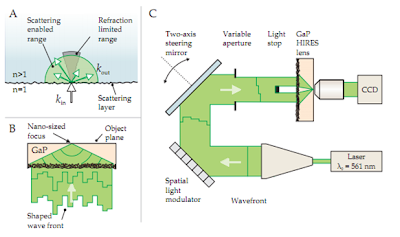Arxiv – Scattering Lens Resolves sub-100 nm Structures with Visible Light
The results open the way to improve resolution in a wide range of optical imaging techniques. The robustness of a HIRES-lens against distortion and abberation, together with their ease to manufacture, makes them ideal for the imaging of fluorescent labeled biological samples or for the efficient coupling to metamaterials and plasmonic nanostructures. Recent developments in spatio-temporal control of waves in disordered materials suggest the possibility for HIRES-lenses to create ultrashort pulses in a nano-sized focus. The fact that a HIRES-lens is a linear technique opens the possibility to use it for resolution improvement of a large range of existing linear and non-linear imaging techniques, such as confocal microscopy, STED, PALM,and STORM.
Mosk and co achieve their trick using a flat piece of frosted glass (ie a transparent slab which is etched on one side in a way that entirely scatters the light that passes through). Here’s how.
First, imagine what this frosted slab does to a plane wave of light passing through it. The flat wave hits the etched surface and scatters in all directions. Some of the light then continues into the glass although the wave front is no longer flat but dramatically distorted. The distorted light then emerges from the other (clear) side of the glass and now appears as a kind of random speckle.
Mosk and co record this distorted wavefront using a CCD chip and work out its shape.
Now imagine the set up again with a slight difference. This time, before the plane light wave hits the scattering surface, Mosk and co send it through a spatial light modulator which can distort the wave in any way they like.
Mosk and co could use the information from the first experiment to bend the incoming wave in exactly the right way to cancel out the distortion due to the scattering layer. Astronomers use this approach to correct light from stars that is distorted by the atmosphere.
But actually Mosk and buddies go further. They distort the incoming plane wave in such a way that the scattering layer causes it to come to a focus. The important point, however, is that this focal point is much tighter than can be achieved with an ordinary lens that relies on refraction alone. This is what allows the higher resolution.
Their equipment is so precise that it can control exactly where the focal point appears and can even move it around. That allows them to build up an image by scanning the focal point back and forth across the object under investigation to build up a 2D image.
Mosk and co demonstrate the technique by imaging gold nanoparticles just 97 nm across but say it should work down to 72 nm. “Our work is the first lens that provides a resolution in the nanometer regime at visible wavelengths,” they say.
That’s an elegant and powerful technique that could have wide application. The lens, which is actually a flat slab of gallium phosphide that has been acid-etched on one side, is cheap and easy to make. It is also free of the aberrations and distortions that plague conventional refraction-based designs.
If you liked this article, please give it a quick review on ycombinator or StumbleUpon. Thanks

Brian Wang is a Futurist Thought Leader and a popular Science blogger with 1 million readers per month. His blog Nextbigfuture.com is ranked #1 Science News Blog. It covers many disruptive technology and trends including Space, Robotics, Artificial Intelligence, Medicine, Anti-aging Biotechnology, and Nanotechnology.
Known for identifying cutting edge technologies, he is currently a Co-Founder of a startup and fundraiser for high potential early-stage companies. He is the Head of Research for Allocations for deep technology investments and an Angel Investor at Space Angels.
A frequent speaker at corporations, he has been a TEDx speaker, a Singularity University speaker and guest at numerous interviews for radio and podcasts. He is open to public speaking and advising engagements.


